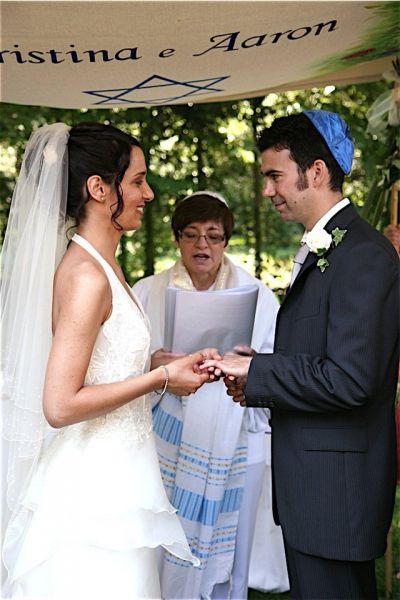A ciascuna fede il proprio matrimonio ed i propri riti religiosi. Chi professa un determinato credo, desidera celebrare queste importanti occasioni secondo i canoni della propria confessione. Ciascuna fede prevede rituali e codici che traggono origine da tradizioni diverse, anche se l’emozione è ovviamente la stessa. Nella religione ebraica, il matrimonio e il Bar e Bat Mitzvah - termini per indicare il momento in cui un bambino e una bambina ebrea raggiungono l’età della maturità diventando responsabili per loro stessi nei confronti della legge ebraica in considerazione della coscienza nel distinguere il bene e il male - presentano rituali molto affascinanti.
The most common of all interfaith partnerships are Italian-Jewish, so it is quite possible that during the spring or summer months, you will have the opportunity to attend a Bar or Bat Mitzvah celebration or a Jewish wedding. As you make your plans to attend a Jewish simcha (joyful occasion), here are some tips that will help you enjoy the festivities.
You’re Invited to a Jewish Wedding
A Jewish or Jewish Interfaith wedding overflows with joy and tradition and often begins with an inclusive ceremony held under the bridal canopy – in Hebrew, the chuppah (pronounced “hoo-pah”). For modern Jews and for interfaith couples, you can expect that the ceremony will be conducted by a rabbi or co-officiated by a rabbi alongside clergy of another faith in English or the native language of the bride and groom and accompanied by Hebrew prayers and blessings.
As interfaith ceremonies become more commonplace, many rabbis are often asked to officiate for celebrations where Jewish traditions and other faiths are combined to create a personalized ceremony that acknowledges the heritage of both the bride and the groom. For this reason, couples often create a printed program explaining Jewish rituals and traditions printed alongside the Catholic, Protestant, Hindu, or Buddhist rituals; in an effort to make all the guests feel comfortable and included.
When you arrive at the wedding venue, often men are presented with a head covering called a kipah or yarmulke. It is customary for men to wear the kipah during the service. When you take a kipah, do check inside. Often the names of the bride and groom are printed there along with the wedding date making it a lovely keepsake.
There are three important moments in the Jewish wedding. The first is the solemn exchange of wedding rings which is considered the moment of marriage. This is followed by the Seven Wedding Blessings (“Shevah Brachot”) where the bride makes seven circles around the groom. The circles symbolize the creation of the walls of the home and refer to peace, love and protection or shalom bayit which means “peace in the home.” Finally, one of the most well-remembered traditions of the Jewish wedding occurs at the end of the ceremony when the groom breaks a glass with his heel and guests shout a hearty “MAZEL TOV!”
During the reception, the bride and groom are hoisted high on chairs. Traditionally, everyone circles the couple dancing the Hora – some Italian historians say it is a form of the Tarantella! Guests join in as the band plays the traditional Hora melody, Hava N’gila.
You’re Invited to a Bar or Bat Mitzvah
This ritual of passage is usually held at a synagogue where the guest of honor reads directly from the Torah scroll – a sacred Jewish document that contains the five Books of Moses written in hand calligraphy in the Hebrew language, the original language of the Bible. Like the Jewish wedding, guests will be given the opportunity to wear a kipot or yarmulke.
During the service, guests will be given a prayer book or siddur. In modern Jewish services, the siddur is printed in Hebrew, English and transliteration, meaning the Hebrew words are written using the English alphabet, allowing worshippers to pronounce the words and sing along with the prayers and blessings.
During the service, the honoree has the chance to carry the Torah scroll through the congregation. Guests may touch it with their fingers or use their prayer book to touch the scroll, an act that symbolizes that the Bible belongs to all of us.
The most popular gift for a Bar or Bat Mitzvah honoree is the gift of money, often saved as part of a college fund or contributed to a “Mitzvah Project,” a project designed to make the world a better place.
Dress is always a question for any type of celebration. Typically, women and girls are asked to dress modestly with shoulders covered, no plunging necklines, open-back dresses or micro-minis. For men and boys, a coat and tie are always appropriate or an open-collar shirt with a jacket will work well, too.
The Jewish wedding and the Bar and Bat Mitzvah ceremonies are joyful celebrations. Share the joy with family and friends and know that in our Jewish tradition, you are blessed for having been a part of these special moments.
Rabbi Barbara Aiello lives and works in Calabria and is Italy’s first woman rabbi. She is also program host for the Radio Rabbi program, heard every Sunday morning at 9 a.m. on Tampa Bay’s AM 940 The Answer and by podcast throughout the week at www.RabbiBarbara.com. If you have questions or comments, This email address is being protected from spambots. You need JavaScript enabled to view it.



